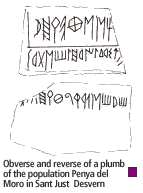
The language and script of the Iberian civilization
Up to now the Iberian language has still not been deciphered. It can be read, the value of the written signs is known, but the meaning of the words is not. This difficulty is caused by the fact that there are no parallel languages.
 It seems to have begun in the area of Low Andalusia, in Tartessos, as early as the VI. Century BCE. and spread all over the Iberian cultural area, meaning the complete Mediterranean coastline of the peninsula up to Southern France.
It seems to have begun in the area of Low Andalusia, in Tartessos, as early as the VI. Century BCE. and spread all over the Iberian cultural area, meaning the complete Mediterranean coastline of the peninsula up to Southern France.
The system of Iberian script consists of 28 signs, both alphabetic and syllabic, and can be written in both directions, from right to left and vice versa. These signs were copied from the Phoenician or Greek alphabet, although with a different phonetic value.
It is understandable that because the Iberian area spread so far, that various dialects were spoken, which could have been generated by the previous inhabitants of every zone and influenced by contacts established with people speaking other foreign languages: Greek, Phoenician and Indo-European.

The inscriptions of the Catalan territory belong to the Levantine dialect, written from left to right, contrary to most meridional dialects. These texts, from no earlier than the IV. Century BCE, were certainly invented in the previous century with the Greek alphabet as a base, so there is an enormous similarity between the signs. These inscriptions might equally appear on metal, pottery or stone. The longest texts are those incised with a punch on lead sheets.